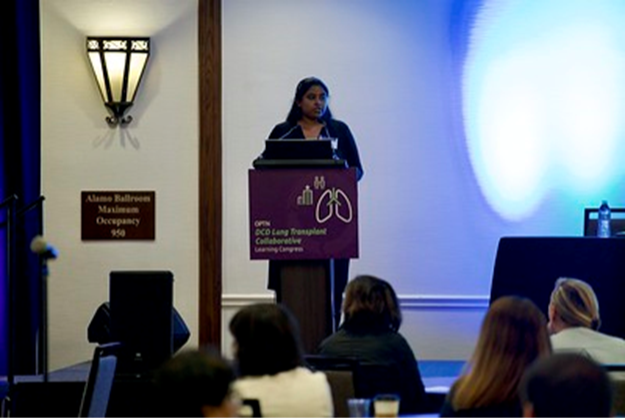Goals exceeded by participants in two national OPTN Collaboratives aimed at sharing organizational learning, driving improvement
Published on: Thursday, May 16, 2024
Transplant organizations across the country are seeing increases in donation after circulatory death (DCD)[1] lung transplants and acceptance rates for donated liver, hearts and kidneys after the conclusion of two Collaboratives sponsored by the Organ Procurement and Transplantation Network (OPTN). Collaboratives are an opportunity for transplant programs and organ procurement organizations (OPOs) to increase transplants and identify and share effective practices. Over the course of nearly two years, more than 100 transplant programs across the U.S. participated in one or both Collaboratives. Participants in the OPTN DCD Lung Transplant Collaborative exceeded their goal of increasing DCD lung transplants by 30 percent while participants in the OPTN Offer Acceptance Collaborative successfully increased acceptance rates for liver, heart, and kidney.
Collaborating to improve: Results and Key takeaways
DCD Lung Transplant Collaborative: December 2022 – July 2023

Sravanthi Nandavarm, Lung Transplant Medical Director, University of Kentucky Medical Center
“The Collaborative helped us grow over all our lung transplant program, we started to do DCD lung transplants more…we improved our collaboration with other centers. We didn’t do [DCD lung transplants] before so that was definitely a plus for us.” — Sravanthi Nandavarm, Lung Transplant Medical Director, University of Kentucky Medical Center
This Collaborative aimed to address the variation in DCD lung transplants and increase the number of DCD lung transplants at both the individual program and community levels.
Forty-five percent (29 programs) of all adult lung transplant programs nationwide voluntarily joined this Collaborative and focused performance improvement efforts across two key areas:
- Optimizing internal transplant processes and patient care practices
- Strengthening collaboration with Organ Procurement Organizations (OPOs)
Results:
Throughout this eight-month Collaborative, participants aimed to increase the number of DCD lung transplants by 30 percent over the previous eight-month period.
- During the active engagement period, the 29 participating programs surpassed their collective aim by increasing DCD lung transplants by 45 percent[2]
- 38 percent of participants met or exceeded their individual aims which ranged from performing one to 21 DCD lung transplants
The Collaborative concluded with a Learning Congress that provided an opportunity for transplant and donation professionals to share effective practices, discuss challenges, and provide insights into improvement work on this topic. Read more about the Learning Congress.
Find additional details in the Collaborative’s Executive Report on the OPTN website.
Offer Acceptance Collaborative: January 2023 – July 2023

Ryutaro Hirose, M.D., Surgical Medical Director, Scientific Registry of Transplant Recipients (SRTR)
“It’s a guiding principle that we want to do as many successful transplants as possible to save as many lives as possible for all those folks waiting on the transplant list. What we want to do in this Collaborative is to make sure that every organ that’s possibly used or possibly usable is utilized by an appropriate patient.” — Ryutaro Hirose, M.D., Surgical Medical Director, Scientific Registry of Transplant Recipients (SRTR)
This Collaborative aimed to address the variation in offer acceptance practices and improve offer acceptance rates at both the individual program and community level. Eighty-three adult and pediatric programs transplant programs nationwide voluntarily joined this Collaborative and focused performance improvement efforts across four key areas:
- Revising and defining acceptance criteria
- Optimizing the response to organ offers
- Performing retrospective reviews
- Strengthening waitlist management processes.
The cohort included kidney, heart, liver, and lung program types.
Results:
Throughout the six-month Collaborative, each organ specific group had a collective goal to increase offer acceptance rates during the active engagement period compared to the previous six-month period. Kidney, liver, and heart cohorts exceeded their goals of increasing offer acceptance rates.
| Kidney cohort | Liver cohort | Heart cohort | Lung cohort | |
|---|---|---|---|---|
| Cohort goal | Increase offer acceptance rate by 20% | Increase offer acceptance rate by 15% | Increase offer acceptance rate by 15% | Increase offer acceptance rate by 15% |
| Cohort goal results | Increased offer acceptance rate by 21% | Increased offer acceptance rate by 46% | Increased offer acceptance rate by 42% | Cohort offer acceptance rate decreased by 11% |
Find additional details in the Collaborative’s Executive Report on the OPTN website.
The OPTN convenes and supports the member community through a wide range of Collaborative improvement initiatives. Every OPTN Collaborative aligns with a particular area of interest in the organ donation and transplant community, and brings peers together to learn from one another.
Questions?
Please email ci@unos.org to learn more about collaborating to improve donation and transplant.
[1] Of note: the OPTN implemented Lung Continuous Distribution policy on March 9, 2023, which was during the active engagement period.
[2] Donation after circulatory death or DCD, refers to the recovery of organs and or tissues from a donor whose heart has irreversibly stopped beating, previously referred to as non-heart beating or asystolic donation.


